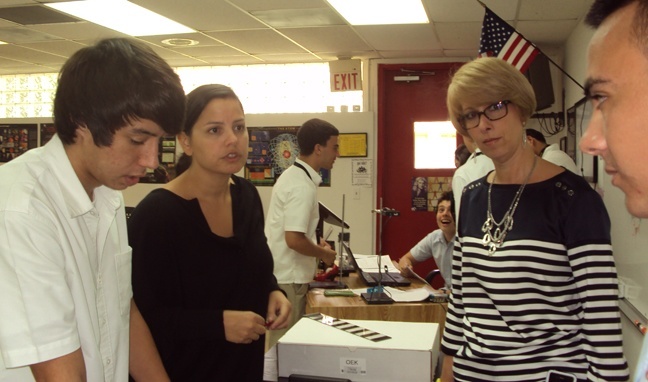By Toni Jane Pallatto - St. Theresa School (Little Flower)

Photographer: TONI PALLATTO | FC
Msgr. Pace physics and chemistry teacher Juliette Victoria, left, encourages her students to conduct scientific analysis. Next to her is the school's principal, Ana Garcia.
MIAMI GARDENS � Juliette Victoria, physics and chemistry teacher at Msgr. Edward Pace High School, received exciting news last month from one of her physics professors at Florida State University. She has been selected to participate in a one-month research project at the CERN laboratory in Geneva, Switzerland this summer.
 �We exploit the relationship between the path of the particle and the magnetic field in which it travels to see what comes out of the collisions,� said Victoria. �It is kind of like recreating the conditions after the Big Bang.�
�We exploit the relationship between the path of the particle and the magnetic field in which it travels to see what comes out of the collisions,� said Victoria. �It is kind of like recreating the conditions after the Big Bang.�
�I worked with Dr. Horst Wahl for two semesters in experimental physics at FSU,� said Victoria. �He contacted me to advise that I and one other Florida high school teacher had been selected among Florida teachers to receive this CMS Fellowship.�
The funding is provided by the National Science Foundation and the Department of Energy.
CERN, the European Organization for Nuclear Research, is the largest physics experiment in the world, with international collaboration from thousands of scientists. The concentration is on fundamental physics, striving to find out what the universe is made of and how the particles work.
The largest and most complex scientific instruments, particle accelerators and detectors, are used to study the components of matter. The accelerators boost beams of particles to high energies before they are made to collide with each other, while the detectors observe and record the results of these collisions.
�Within its complex structure of the Large Hadron Collider (LHC) at CERN, there are six detectors. I will be working at the Compact Muon Solenoid (CMS), which is one of the six,� said Victoria. �The CMS detector has a super conducting wire that looks like a slinky but much bigger and produces a large magnetic field.�
Two beams of protons travel in opposite directions inside the circular accelerator, gaining energy with every lap. The two beams collide head-on at very high energy.

Photographer: TONI PALLATTO | FC
Msgr. Pace physics and chemistry teacher Juliette Victoria, second from left, guides her students in an optics bench experiment.
By studying what happens when these particles collide, physicists learn about the laws of nature and its composition.
�We are so proud of Juliette,� said Elva Reigosa, public relations coordinator for Pace High School. �She truly brings the excitement of physics and science to the classroom.�
�This past October when the area middle schools were visiting us, she created a marvelous Haunted House Halloween lab for her students,� Reigosa said. �They, and the visiting middle schoolers, were thoroughly engaged in the learning experience.�
�Ms. Victoria makes the classroom extremely interesting,� said Luz Madera, a junior student in her class. �We were able to interact with two graduating physicists from FSU, via Skype. We discussed mass versus matter, and it gave us a hands-on approach. It has motivated me to want to major in physics.�
�I was able to ask the physics graduates from FSU where God plays into all of this,� said Sebastian Zamudio. �It wasn�t something they would really talk about since they are a part of a public institution. But since we are a Catholic school, we discuss this in our class, looking at how science and religion coincide.�
�With all of my studies, I have become even more Catholic,� said Victoria, a 1994 graduate of Pace as well as a graduate of St. John the Apostle in Hialeah. �It all boils down to energy. When you look at the atom, you wonder what is holding it all together. There comes a time when you cannot explain anymore. Then you are looking at the awesomeness of God.�
How will Victoria integrate this experience into her classroom teaching?
�I will be further encouraged to teach particle physics in the classroom,� she said. �I will be better able to facilitate it because I will have the in-person, hands-on, real stories that come from this deep study. I have to thoroughly understand it to be able to explain it to teens. And, finally, I want to inspire and capture students� imaginations. They will be the scientists, teachers, voters and decision-makers of the future. I will be influencing their critical thinking.�
�Juliette is a shining example of a Pace graduate that continues to accomplish great things,� said Ana Garcia, the school�s principal. �This is not just about her. She brings honor and respect to all of us as a school.�
Victoria will be �Twittering� her experiences this summer. You can follow her @PaceMsVictoria2.

